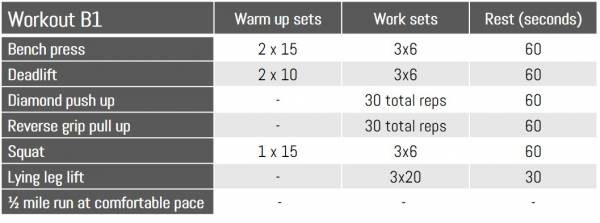From a physical training perspective, boot camp is an interesting animal. I started weight training at 14 years old and entered into boot camp (or Basic Military Training, BMT) at 17. Even though I had a few years of consistent resistance training under my belt, it still didn’t properly prepare me for the variety of physical challenges of the military. While I had focused exclusively on adding muscle, I lacked in the more functional aspects of the very muscle I was building.
I made it through just fine, out of pure necessity and the fact that I always promise myself to finish what I start. Now, after a 21-year career, I’m a not-so-old retired guy (I’m 42), and can look back with the advantage of hindsight to formulate a comprehensive plan for boot camp prep.
The importance of running and performing numerous reps of push ups every day are obvious enough. But I believe you have the opportunity to optimize your training with a wider variety of exercises and an informed knowledge of training and nutrition. With the program I’ll outline today, you can build an incredible foundation that will help you not just survive, but excel during basic training.
Even if you have no plans to join the military, there are those of you out there who still want to experience the same type of training. It’s not enough to just be able to run long distances or be stronger in the general sense. You want more out of your training, and becoming boot-camp-ready will give you a unique level of physical capability.
Your Marching Orders
Below you’ll find a 12-week boot camp prep program designed to get you to jump, lift, push, pull, drag, and carry better than ever. You’ll also perform conditioning drills, endurance challenges, and functional bodyweight exercises. Use it for entering into the ranks of the military, or just to get into beastly shape. Whatever your reasons, give it your all and don’t look back.
Follow the program as it’s laid out, but remember that the body isn’t a machine. Pay close attention to your recovery. If you need a breather in the middle of the program, take a week off after six weeks, and participate in some active recovery exercises. Additionally, all of the exercises aren’t set in stone. If you need to adjust, do so. Just make sure you are still challenging yourself without trying to take the easy route. Set volume and rest can be adjusted as well.
If life gets in the way and you get off track for a day or two, simply pick up where you left off. Don’t adopt an all-or-nothing mentality and throw in the towel at the first speed bump. Have fun with the program. Don’t be a slave to your workouts; they shouldn’t feel like work. Take on each day as a challenge and seek weekly improvement. If it isn’t fun or interesting, find another program or mode of exercise entirely.
The Boot Camp Prep Program
This program is equipped with all the tools to get you in boot camp shape. It is split into four, three-week segments. Every three weeks, you’ll adjust exercises and rep schemes to keep things progressing and interesting. As you move along the program, your intensity and volume will steadily increase, as your time will remain unchanged. This is referred to as training density.
Weeks 1 Through 12 on Training Whiteboard
Weeks 1-3
You will begin by training three nonconsecutive days per week, such as Monday, Wednesday and Friday. You will rotate workouts A1 and B1 on those nonconsecutive days. So Monday will be A1, Wednesday will be B1, and Friday will be A1 again. On the following Monday, you’ll start where you left off with B1.







